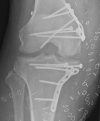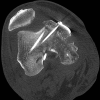[Reconstruction of large osteochondral defects of the distal femur and proximal tibia : Adaptation of fresh frozen allografts using 3D-printed models]
- PMID: 32776223
- PMCID: PMC7810632
- DOI: 10.1007/s00113-020-00846-y
[Reconstruction of large osteochondral defects of the distal femur and proximal tibia : Adaptation of fresh frozen allografts using 3D-printed models]
Abstract
The reconstruction of large osteochondral defects is still a challenge in musculoskeletal surgery. Fresh frozen allografts are a frequently used resource for the treatment of such tissue defects. Furthermore, 3D-printed models enable multiple options in the preoperative planning and intraoperative adaptation of the allografts, so that healing is optimal and the best functional outcome for the patient is achieved.
Die Rekonstruktion großer osteochondraler Defekte stellt nach wie vor eine Herausforderung in der muskuloskeletalen Chirurgie dar. Frisch gefrorene Allografts sind eine häufig genutzte Ressource für die Behandlung solcher Gewebedefekte. Darüber hinaus ermöglichen 3D-gedruckte Kunststoffmodelle vielfältige Optionen in der präoperativen Planung und bei der intraoperativen Anpassung der Transplantate, sodass sie optimal einheilen und das bestmögliche funktionelle Ergebnis für den Patienten erreicht wird.
Keywords: 3D-printed model; Fresh frozen allograft; Osteochondral reconstruction; Reconstruction of defect; Three dimensional printing.
References
-
- Deutsche Gesellschaft für Gewebstransplantation . Jahresbericht 2018. 2019.
MeSH terms
LinkOut - more resources
Full Text Sources







